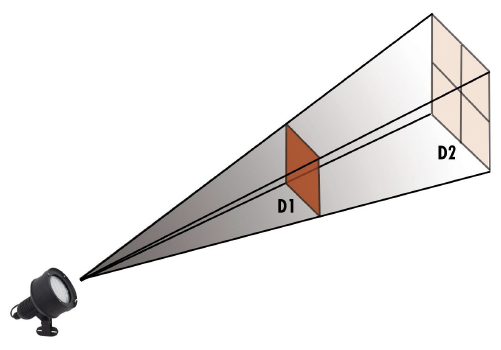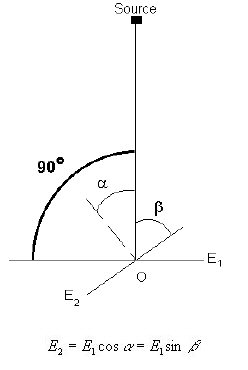
IR Illumination Range and Angle Information - The Inverse Rule
Infra red light performs just like any other illumination, the farther you get away from the point of illumination (called the Point source) the weaker the illumination becomes. The level of illumination drops off sharply as the distance increases as it is inversely proportional to the square of the distance away from the light. So if you double the distance you will get ¼ of the illumination! This is called the “Inverse Square rule”

The inverse square law tells us that the illumination is inversely proportional to the square of the distance between the point source and the surface. This is because infrared light is spread both horizontally and vertically in 2 separate X & Y planes and the area of which (X*Y) is where the illumination is distributed.
This means that if we say D1 is at 50 meters and D2 is at 100mtrs the illumination at D2 will be the ¼ the strength of that at D1 (½ x2). This is an important rule as if we double the distance again from the point source the illumination would fall to 1/16th (¼x4) at such distance. So when you are working out which lamp you need remember the light is a lot stronger near the lamp than at its max range which is quoted as a guide only as full range and response will also depend on the camera's IR sensitivity.
What about the angle of the IR-light to the object it’s trying to illuminate?
If you have ever used a flash in photography you will be aware that if light hits a surface head on at 90 degrees it reflects back well and can ruin the picture! The lesson here is that the closer to 90 degrees that the illumination hits its target the better the target gets illuminated. The greater the angle of incidence to the area to be illuminated the weaker the reflected light back in to the CCTV camera. This rule we call the cosine rule. The cosine rule is stated as below.;

Effective illumination is proportional to the cosine of the angle of incidence of the light on the surface (angle between the direction of the light and the perpendicular to the surface) Illumination at the O point on surfaces 1 and 2:
Here are a few examples
When the surface is tilted so the angle of illumination is now 70º, the illumination is reduced by a factor of 0.87 i.e. it is now only 87% as good! Similarly 45 degrees reduce the illumination to 71% and so on. We can use the Cosine law to indicate the loss of effectiveness of the IR lighting as the angle between the light and the object changes.
This is summarised in the table below.
Angle of illumination to subject
90 degrees
70 degrees
45 degrees
30 degrees
Effective power
100 percent
87 percent
71 percent
50 percent
